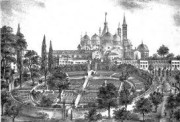Brief City’s History
The name of the city was, at first, Zyz for the Phoenicians, which meant flower; Panormos for the Greeks and Panormus for the Romans, which meant a whole port; Balarm for the Arabs with no particular meaning and finally Balermus for the Normans, which anticipated the modern name Palermo. The two old rivers Kemonia and Papireto, upon which the City was built, are now no longer visible because flowing underground. Men were already there, in the area, in Paleolitic Era, but the actual City was founded by the Phoenicians between the VII and the VI century B.C. The Greeks, who lived around the City of Syracuse, in the oriental area of Sicily, rarely attacked the other Phoenician zone, but sometimes they ransacked the City, until the Romans conquered it, ruling for a long and prosperous period until the Barbarian Invasions. Palermo was ravaged during the Barbarian Invasions ( 535 A.C. ), but afterwards reconquered by the Byzantine Oriental Roman Empire, which for three centuries dominated the entire Isle, making it a province of the Empire. In 827 A.C. the Berbers of Northern Africa invaded Sicily and in 831 Palermo was taken. The Arabians transformed all the Churches into Mosques, transferring the Capital from Syracuse to Palermo, introducing the plantations of lemons and oranges and so making the City become larger and more densely populated. Afterwards the Normans, after a neverending siege, took the City, mantaining the Muslims and mixing with them. Their Reign lasted until other European reigning Dynasties took over: the Swabians ( 1194 – 1266 A.C. ), the French Angioinians ( 1266 – 1282 A.C. ), the Spanish ( 1516 – 1713 A.C. ) and finally the Italian Bourbons in 1734 A.C., who ruled both the Reigns of Sicily and Naples, which were fused togheter in 1816 A.C. into the Reign of the two Sicilies. In 1860-61 A.C., with the landing of Garibaldi, this Reing was annexed to the Reign of Italy.
The City
 Palermo is a charming City, with a wonderful sea, a complex history made of many population who have inhabited there, with an antique historic City Center full of terrific monuments, Churches. markets and traditional alleys with an intense Mediterranean In Palermo, indeed, all these monuments tell the history of the City; most of them are in the historic City Centre, some others instead, as antique Villas, Churches, Watch Towers and Noble Mansions, are in the surroundings.. City full of contrasts and beauty is surely one recommended stop in your trip around Italy. Then what about the Sicilian gastronomy … it has some really interesting dish as pasta with sardines, bread and pannelle, busiata pasta with garlic, Sicilian cassata ( dessert ), granita with brioches ( icecream ), Sicilian arancino, cannolo with ricotta cheese ( pastry ) and almond paste …just to mention a few. Then … if, after an artistic and cultural tour of the monuments, you’d like to relax sprawled on a beach, you can lay in Mondello beach, Addadura beach, Sferracavallo beach or on the Isola delle Femmine beach.
Palermo is a charming City, with a wonderful sea, a complex history made of many population who have inhabited there, with an antique historic City Center full of terrific monuments, Churches. markets and traditional alleys with an intense Mediterranean In Palermo, indeed, all these monuments tell the history of the City; most of them are in the historic City Centre, some others instead, as antique Villas, Churches, Watch Towers and Noble Mansions, are in the surroundings.. City full of contrasts and beauty is surely one recommended stop in your trip around Italy. Then what about the Sicilian gastronomy … it has some really interesting dish as pasta with sardines, bread and pannelle, busiata pasta with garlic, Sicilian cassata ( dessert ), granita with brioches ( icecream ), Sicilian arancino, cannolo with ricotta cheese ( pastry ) and almond paste …just to mention a few. Then … if, after an artistic and cultural tour of the monuments, you’d like to relax sprawled on a beach, you can lay in Mondello beach, Addadura beach, Sferracavallo beach or on the Isola delle Femmine beach.
Here are the main Monuments to visit in Palermo:
1. The Cathedral: there, Santa Rosalia, the Patroness of Palermo, rests. The Cathedral was initially an early Christian basilica, then transformed into a Mosque during the Arab domination and finally again a Church thanks to the Normans. The Arab-Norman style initially distinguished the Cathedral, with Gothic and Baroque details; later on, in the mid-1700 AD, thanks to the architect Ferdinando Fuga, the Cathedral took on a decidedly neoclassical aspect, with the exception of some details still present in the main apse (Arab-Norman), in the main entrance portal (Gothic) and in the dome (baroque). Inside are the tombs of Frederick II and, above all, the tomb of Santa Rosalia, Patron Saint of the City.
2. Martorana Church: this wonderful Byzantine Church dates back to 1143 AD. and it was built by Admiral Giorgio d’Antiochia, at the time of the Norman king Roger II. The strong contrasts between the Baroque and the Arab-Norman styles have determined its particular beauty. The rich interior decorations make it a splendid example of Byzantine art. The Church was ceded in 1433 AD. from the noble Eloisa Martorana to the nearby Benedictine Monastery and so it took her name. It was the seat of an Italian-Albanian community and since then, despite being dependent on the Holy See, it follows the Orthodox liturgical calendar.
3.The Royal Palace: this great mansion, built on a previous Roman structure then become an Arabian defensive stonghold and finally centre of the Norman political life of Palermo, is therefore also famous as the Norman Palace. Its style is due to the many dominations suffered by Palermo, from a Renaissance style to the Arab-Norman taste of the adjacent Pisan tower. Its Palatine Chapel, dedicated to Saints Peter and Paul and built in 1132 AD, with gorgeous golden decorations consisting of mosaics made with golden pieces in the Arab-Norman style, was the place where the royal family prayed. On the second floor there is a residential area that now houses the Sicilian Regional Assembly.
4. San Giovanni degli Eremiti Church: this Church with the Convent of S. Giovanni degli Eremiti were built , between 1132 AD and 1148 AD, by Ruggero II, the first King of Sicily. A man of an high cultural level. During the Muslim rule, it probably became an Arab mosque and aferwards abandoned for a long time. Subsequently, in 1464 AD, Pope Paul II donated the complex to the Benedictine monks, who in 1524 AD made it become their hospice. The Church and the Monastery have been built by the Normans with a partially Islamic architectural style. They are the representation of Christian and Muslim cultures, which merged to give rise to a very particular new style.
5. The Teatro Massimo: this Theater is a large and fascinating building dating back to 1875 AD, built in a neoclassical style, which houses several cylindrical rooms. The most important is the large Stalls, which houses 155 dais on five floors including the royal dais; then laterally there are the others: the UN room, the Pompeian room and the Hall of coats of arms.
6. Sanctuary of Santa Rosalia: Rosalia was the daughter of Sinibaldo, the lord of Quisquina. The story goes that this young girl went to live in a cave located on Monte Pellegrino, where other hermits also lived. Rosalia Sinibaldi did not yearn for the temptations of common life, and for this reason she consecrated herself to Christ by retiring to this narrow and dark cave and dying there still young. After several centuries, in 1624 AD, his bones were, it seems, found and brought to Palermo where shortly after the plague, which was then spreading, miraculously disappeared. Its cave so became a place of pilgrimage and Santa Rosalia became the Holy Patron Saint of Palermo.






